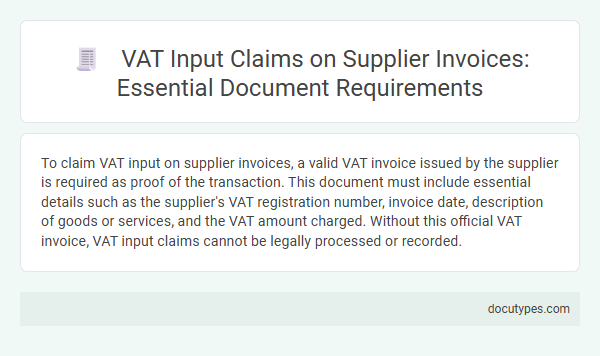To claim VAT input on supplier invoices, a valid VAT invoice issued by the supplier is required as proof of the transaction. This document must include essential details such as the supplier's VAT registration number, invoice date, description of goods or services, and the VAT amount charged. Without this official VAT invoice, VAT input claims cannot be legally processed or recorded.
Understanding VAT Input Claims on Supplier Invoices
Understanding VAT input claims on supplier invoices is essential for accurate tax reporting and compliance. Proper documentation ensures your VAT input claims are valid and recognized by tax authorities.
- Supplier Invoice - A valid supplier invoice must include the supplier's VAT number, invoice date, and VAT amount charged to support your input claim.
- Purchase Proof - Evidence of the purchase transaction, such as delivery notes or contracts, helps validate the legitimacy of the VAT input claim.
- Compliance with Local VAT Laws - The document must comply with your country's VAT regulations to be accepted for VAT input claims during tax submissions.
Key Legal Requirements for VAT Input Documentation
To claim VAT input on supplier invoices, the primary document required is a valid tax invoice issued by the supplier, which must include their VAT registration number, the date, and a detailed description of goods or services supplied. Legal requirements dictate that the invoice should clearly state the VAT amount separately to ensure accurate input tax reporting. Compliance with these documentation standards is essential for businesses to substantiate their VAT claims and avoid penalties during tax audits.
Essential Supplier Invoice Details for VAT Input Claims
To claim VAT input on supplier invoices, the document must clearly display essential information. This includes the supplier's name, VAT registration number, invoice date, and a unique invoice number.
The invoice should also detail the description of goods or services supplied, the taxable amount, VAT rate applied, and the total VAT charged. Accurate and complete supplier invoices ensure compliance and successful VAT input claims.
Common Mistakes in VAT Input Documentation
To claim VAT input on supplier invoices, a valid tax invoice or an equivalent VAT document is required. This document must clearly display the supplier's VAT number, invoice date, and the VAT amount charged.
Common mistakes include using incomplete invoices that lack essential details such as the supplier's VAT registration number. Another frequent error is submitting invoices that do not separate the VAT amount from the total price, making it impossible to verify the VAT claim.
Verification Process for Valid Supplier Invoices
Accurate verification of supplier invoices is crucial for claiming VAT input to ensure compliance with tax regulations. Proper documentation supports the legitimacy of VAT recovery and minimizes audit risks.
The verification process focuses on confirming invoice authenticity, completeness, and compliance with VAT requirements.
- Invoice Authenticity Verification - Confirm the supplier's identity and the invoice's issuance date to ensure it is a legitimate document.
- Invoice Completeness Check - Verify that the invoice includes essential details such as supplier VAT number, invoice number, transaction date, and a clear description of goods or services.
- VAT Compliance Validation - Ensure the VAT amount is accurately calculated and the invoice meets statutory requirements under relevant VAT laws for reclaim eligibility.
Importance of Accurate Tax Identification Numbers
| Document Required for VAT Input Claim | Valid Supplier Invoice |
|---|---|
| Key Element | Accurate Tax Identification Number (TIN) |
| Importance | Ensures compliance with tax regulations and enables proper validation of VAT input claims. |
| Consequences of Incorrect TIN | Delayed VAT refunds, potential audits, and rejection of VAT input claims. |
| Recommendation | Verify Your supplier's TIN on each invoice to secure claim legitimacy and avoid tax discrepancies. |
Handling Missing or Incomplete Invoice Information
To claim VAT input on supplier invoices, you must possess a valid tax invoice that clearly displays the supplier's tax identification number, invoice date, and a detailed description of the goods or services provided. Without this specific documentation, VAT input claims may be disallowed during tax audits.
If the invoice information is missing or incomplete, contact the supplier promptly to request a corrected tax invoice containing all required details. Keep records of all correspondence as evidence of your due diligence. Ensuring accuracy in your documents helps maintain compliance with VAT regulations and supports your input tax claims. Your proactive management of invoice accuracy safeguards against potential financial penalties or disallowed claims.
Electronic vs. Paper Invoices for VAT Claims
Claiming VAT input requires proper documentation of supplier invoices, which can be either electronic or paper-based. Understanding the validity and requirements of each format is essential for accurate VAT reporting.
- Electronic Invoices are Valid - Tax authorities generally accept electronic invoices as proof for VAT input claims if they meet integrity and authenticity criteria.
- Paper Invoices Require Original Copies - Original paper invoices must be retained as evidence for VAT claims and should clearly show all required VAT details.
- Compliance with Local VAT Laws - Both electronic and paper invoices must comply with jurisdiction-specific VAT regulations to qualify for input tax credits.
Maintaining accurate and compliant invoice records supports seamless VAT input claims and audit readiness.
Record-Keeping Best Practices for VAT Input Claims
The primary document needed for VAT input claims is a valid supplier invoice that clearly displays the supplier's VAT registration number, invoice date, and the amount of VAT charged. Maintaining organized records of all supplier invoices ensures compliance with tax regulations and facilitates smooth VAT audits. Businesses should keep these documents for the statutory retention period, typically five to seven years, to support accurate VAT input claims and record-keeping best practices.
Which Document Is Needed for VAT Input Claimed on Supplier Invoices? Infographic

